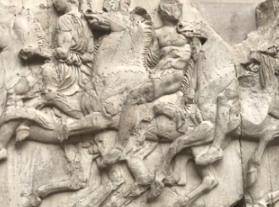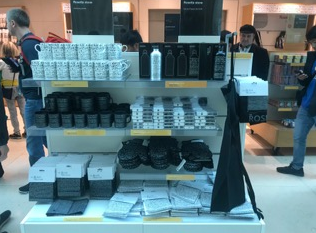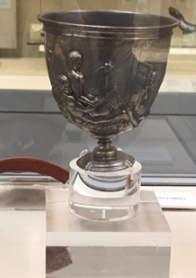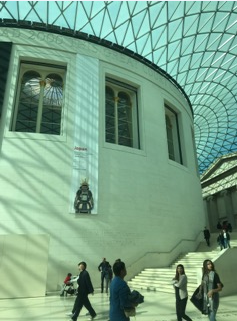Can we buy the marbles sir? A school trip to the British Museum

Phil Brett takes his primary school class for a dialectical trip round the British Museum
I visit the British Museum fairly regularly. Of course, I'm not unique in that. Recent figures show that whilst it has lost its position as the UK's most popular attraction (to the Tate Modern, which was helped by its extension and massive exhibitions such as the Picasso), the British Museum, with 5.8 million visitors and in second place, can hardly be called a ghost town.
However, unlike a lot of those folk who visit, I tend to be accompanied by thirty children under twelve, all wanting the toilet and to know when they can (a) go to the shop and (b) eat their lunch. Even then, I am not special: in the BM Annual Report, it states that approximately 888,000 children attended, and of those 323,000 were on school trips.
Concern around ferrying young children across London and the hassle of filling in risk assessment forms of the equivalent length and complexity of NASA's launches to Jupiter is clearly not too off-putting for teachers. Reasons for a visit are many. The BM has very helpful attendants, there are great educational facilities – and yes, somewhere for the kids to eat, and go to the loo.

The fabulous ground floor of the British Museum
The other attraction is of course the exhibits. These are undeniably wow-inducing. Moving from outside the Greek Revival museum building itself, designed by Sir Robert Smirke RA, into the main courtyard, with its tessellated glass roof (designed by Buro Happold) and then into the ground floor with its huge Greek, Assyrian and Roman artefacts, monuments and sculptures – primary school children like things BIG – it is surely one of the most impressive ground floors of any building, anywhere in the world. Like all museums, it also allows you to roam. Within reason – and within view of the accompanying adult for that group — the children can explore for themselves.
They can also start to ask questions – questions which include ones which have occupied adults for centuries, and some which are still very much in the present. Of course, they are framed in their age-related language and world view, but nonetheless touch upon issues which others, older in their years, still debate.

The mummies – like a magnet for kids
One such issue arises with the trip upstairs to the mummies. No matter what the reason for the visit, a trip there is a must. It is always the noisiest, with children exclaiming wonderment (and sometimes horror). Because of the Horrible Histories books, many will already be acquainted with the Ancient Egyptians, and will talk at length of what they know. It is perhaps their first meeting of history outside of British history — including for such children as those I work with, in inner-London and multi-cultural schools.
The questions that they often ask are why are these people's graves allowed to be opened up and put on show? Is that allowed for anyone else? Is there a time limit for when it is not seen as disrespectful? What is the difference between a myth and an organised religion? Are there ghosts here and will they come alive?. The children from countries outside of Europe, even if not from northern Africa, always enjoy the sense that civilisations existed far in advance of Britain at that time. But then they often ask questions like how did they get in the museum, and should they still be here?
Decolonisation, Nelson, and keeping out the riff-raff
They don't use the term decolonisation, but that is what they are addressing. How much are European institutions – be they universities or museums – part of an imperialist history, which consciously or otherwise, they still uphold? Debate usually ensues within the class – I am referring to thirty upper KS2 children and not in the Marxist sense! Many will simply think it is great that they are here so they can see and learn from them. Others want to hear how these were found, and want to talk about whether people have the right to take things from tombs, and if they do, who is allowed? Should artefacts be sold or worse, simply just taken abroad?
Many of the artefacts in the Egyptian collection, as well as in others, owe their location due to one Horatio Nelson, for having beaten Napoleon at the Battle of the Nile. Because in doing so, he helped hasten France's involvement in that area. With French imperial interests thwarted, the British took over. The famous Rosetta Stone was found in 1799 by Napoleon's envoy – Pierre Francois Bouchard – but after the defeat, France was obliged to hand over all its archaeological discoveries to Britain. Local Egyptians were not consulted. This was soft imperial power, accompanying the harder variety, of the powerful Royal Navy.
This story is very typical of Western European museums. The British Museum – and British Library and Natural History Museum – are founded on collections made by Sir Hans Sloane. As well as having an 80s fashion movement named after him and allegedly creating hot chocolate, he was a keen naturalist and collector. Whilst visiting the Caribbean in 1687, in part to see his wife's extensive slave holdings, he found time to detail the horrific brutality meted out to slaves and to collect plant specimens.
I do not know what action, if any, he took about the former, but he bequeathed the latter to a grateful nation. Here, one might consider what Sumaya Kassim of the Birmingham Museum and Art Galleries, has said – that museums are not politically neutral, because for many white audiences they reflect a romanticised view of the European past, whereas for black and minority ethnic audiences, they represent a continuation of theft and trauma. And I would add – racism. Few museums have seriously embraced putting up explanations of how the context of some of their collections has changed from a colonial trophy, to a thing of curiosity, to a work of world art.
The British Museum, the world's first public national museum, opened in 1753 at its present location but what was then Montagu House. Interestingly, Buckingham House (later Palace) had previously been considered for the location of Sloane's collection. This heralded the growth of museum building, flourishing in the age of Enlightenment, where reason was king.
Of course, enlightenment had its limits. For starters, entry to the building was by ticket only, which you had to apply for. One had to be 'properly dressed' to visit – to keep out the riff-raff from this enlightenment). Eventually, as Britain's Empire grew, so did the nation's' collections of items of scientific, cultural and historical interest. Montagu House was demolished and the museum rebuilt, re-opening in 1852.
The Empire and the Marbles
Within the Empire, the explorer was followed by the merchant and banker accompanying the soldier and the administrator and alongside the scientist and archaeologist. This could be done in the name of Reason, of expanding humanity’s knowledge – all for the greater good! Well, obviously not all – obviously not for those in the colonies, especially the slaves. Or even those in Britain. Yes, a few bits and bobs could be put on show so people could see how 'exotic' the world was, and in doing so, show how far the Empire stretched, but whilst they might be allowed admission, heaven help them if they wanted the vote or to join a trade union. But they could be proud to be British.
But if a visitor nowadays wants some aids to explain how the British Museum came to have such artefacts, they will have to look pretty hard. Most museums are rather reluctant to explain the circumstances of how they came to get them. Words such as 'sourced', 'acquired', 'donated' or 'purchased' are usually used. What they precisely mean, is often left hanging. So Captain James Cook's journeys led to him adding many 'discoveries' to the 'nation', which he 'acquired'. One wonders how. Rooted in such a past, Western European museums, especially the British Museum, have been embroiled in many controversies.

The Parthenon Marbles still draw in the crowds
The best known example of is that of the Elgin Marbles. On a school visit, we usually do visit the Parthenon Marbles, as they are more properly known. The first reaction is one of disappointment, that they are not the type of marbles which the children are familiar with. Nor can they buy them from the shop.
They weren't actually purchased in the first place, but were removed by people working for the 7th Earl of Elgin from the Parthenon between 1801 and 1812. Even at the time there was controversy about this action, with debates in parliament and Lord Byron denouncing it as looting. It should be also stated, for those who may think that at least the theft was for the common good, that Elgin originally took them to decorate his mansion. He only sold them to parliament because of a costly divorce he needed to pay for.
He claimed that he had written permission from the ruling Ottoman Empire. However, despite the Ottoman's being rather keen on paperwork, no copies of this 'permission' have ever been found. But even if this is true, doesn't this smack of a similar situation with the dividing up of treasures between France and England during the Napoleonic Wars? Another example of imperialist powers carving up the world – its people, its resources, history, its culture and – literally in this case – its art.

The case for the defence
Maybe that is why the argument has slightly shifted, and now the case of the Remainers – in the British Museum, the term takes on a whole new meaning! – it is one of conservation. There is a small display which explains that they are here because of the need to conserve them for the world. For me, this is museum colonisation in its most blatant form. From the Victorians claiming the Empire was there to help govern, educate and protect the 'natives' because they couldn't do it themselves, to the British Museum protecting the Marbles because Athens cannot.
I confess that I am no expert on such matters, but I am guessing that Greek archaeologists, historians and renovators have some knowledge of looking after Ancient Greek artefacts. And the British Museum has made some rather large blunders even in the renovation arena, including the 1930 renovation of the Marbles, which not only broke some of them but also gave them an unnatural, white appearance.
Some aspects of decolonising museums, of stripping away at least some of the Imperial legacy which still resonates today, are complex. But some are straightforward. Let's turn the Elgin Marbles into Peter's Marbles, the glass spherical type, which he keeps at school. Edward, a school bully, takes them from him, intending to keep them at his home, claiming that another school bully wrote a note saying he could. But he has left that note at home. In any event, he decides to give them to the school so they can look after them. Are they Edward’s Marbles? The school’s? Of course not, they're Peter's. Give them back to him.
The real reason for inaction is that to return them would fuel a whole host of claims for the return of items presently in the Museum. Amongst many, there would be other Ottoman items to be handed back; the Lewis Chessman back to Scotland, Neanderthal remains back to Gibraltar, the Moai back to the Easter Island and the Lander Stool back to Nigeria. The latter item, like the Elgin Marbles, adds insult to injury, by coupling a European name to an artefact just because he 'found' a piece of Yoruba art. Lagos wants it back. The British Museum has it in storage. For those who fret that returning the controversial items would leave a huge empty space in central London, they might consider that like art galleries (see Art for, and by, the Many by Phil Brett) museums only show a fraction of their collection. In the British Museum's case, only about 1% is on show.
Soft power, revenue and the Sackler Trust
With the post World War 2 boom in tourism, museums and art galleries are important sources of profit-making for British hotel and restaurant owners. They also enhance national status, and help promote – or at least soften – the often cruel and violent reality of colonialism into an image of a powerful but fundamentally benevolent empire. The concept of soft power has changed since the nineteenth century, but not disappeared.

Get your Rosetta Stone souvenirs here! Models of Nelson’s fleet should really be sold alongside them
The children on our school trips love the souvenir shops, but they can only bring in a fraction of the required revenue for museums, no matter how expensive those toy mummies are.
Purchased items in the collections don't come cheap. In 1999 the British Museum bought an exquisite Roman silver cup for £1.8 million, known today as the Warren Cup. In its day, it was the Museum's most expensive purchase. Not only is it an aesthetically lovely item from 1AD, but its depiction of two male lovers has had an important role in the battle for LGBTQ rights, with its first modern day owner – Edward Perry Warren – using it in his 1928 book 'A defence of Uranian Love'. So its value is multi-faceted – but has a massive price tag. Thus like the Elgin Marbles and so many of the other items in the British Museum, it has both progressive and reactionary meanings.

The small but very pricey Warren Cup
More souvenirs can be flogged for the regular 'blockbuster' exhibitions, which can also raise revenues by charging entrance fees. Such exhibitions usually come with sponsorship, often from big corporations and trusts linked to the profits made by billionaire capitalists. Indeed, giving to the arts is a big thing for the multinationals. Not just the temporary exhibitions, but many of the galleries have corporate names – something I become aware of as I arrange to meet my Blue Table Group of children by the entrance to the Raymond and Beverley Sackler Wing.
The Sackler Trust has very recently halted all its 'philanthropic' giving because they say that they don't want to be a distraction from the worthy causes they support. Hmm, maybe! Or maybe they have decided that the controversy over the opioid drug crisis, and their link to the OxyContin scandal in the United States, is damaging their corporate image, like the demonstrations in American galleries which they are sponsoring.
So why have they been giving money in the first place? Care for the common folk? Again, hmm, maybe! Perhaps it’s more like the B list celeb that employs an accountant to stash his money away but always appears for Comic Relief?
It is, as Rob Reich, Professor of Ethics at Stanford University, says – a case of 'reputation laundering'. The British museum itself boasts online of the investment opportunities for a "Great stand-out campaign by aligning your brand with one of the world's most prestigious cultural institutions". People are now questioning this 'philanthropy' more and more. Recently, there was a demonstration against a BP-sponsored exhibition of Assyrian artefacts. The complaint was that whilst BP was posing as the great respecter of other countries' treasures, in modern day Iraq (formerly known as Assyria) it had been very keen to help itself to its oil reserves after the Gulf War. Helen Glynn, a spokesperson for the 'BP or not BP’, who organised the protest, argued that BP wants to be seen "as a good corporate citizen, when it is one of the most destructive companies in the world".
Colonisation does not always come at the end of gun, a jet fighter, or a drone. The spirit of the East India Company lives on in these huge multinationals, helping themselves to as much as they can, from around the world.
Decolonisation has to be serious, not tokenistic, and thus it must include looking at who gives money and what they get in return, and what influence they have (see also The corruption of art and culture by corporate capital by Mike Quille). For in the quite brilliant words of Kassim:
I do not want to see decolonisation become part of Britain's national narrative as a pretty curiosity with no substance - or worse for decoloniality to be claimed as yet another 'great' British accomplishment: the railways, two world wars, the world cup, and decolonisation.

The stunning courtyard, with banners proclaiming the latest exhibition - sponsored by Mitsubishi
This comes at a cost though. Governments see museums, galleries and culture generally as an easy target for cost-cutting. Museums have thus sought alternative streams of revenue for a reason. I doubt very much that the BM's link up with BP is because they fancy a freebie trip to an oil rig. It is the cold cash they bring. So many cultural critics, including the journalist Mark Lawson, have been critical of such protests, saying that in the name of some misplaced virtue, they simply reduce funding. He dismisses such proponents as being the 'New Puritans'. Resisting the response that Puritans helped get Charles I's head cut off, so they can’t have been all bad, there is a more concrete, and less flippant argument.
For socialists it is simple – give more in state funding. Then the counter-argument appears – from where will that money come from? If I look at the pretty pie chart on my annual tax summary, which tells me how my tax and NICs have been spent, what would be cut to pay for this increase? More to culture, but less to welfare or health or education? Interestingly, defence is never offered as an alternative. But the children in my class could answer that – you can always increase the whole which a pie chart represents. In this case, by increasing taxes. One is reminded of the quote of Clement Atlee from 1922:
Charity is a cold grey loveless thing. If a rich man wants to help the poor he should pay his taxes gladly, not dole out money at a whim.
It does not have to be the way it is now. Society changes, has often changed, and can change again. This includes how museums are run and how the world’s history and culture is cared for. Who says important artefacts must be bought and sold? Why should some billionaire own something that rightly belongs to all of us?
Public ownership and democratic control
The answer surely lies in extending public ownership and democratic control of all our important historical artefacts. Remove the expensive market for our shared history. To a limited extent, museums already share and cooperate on an international basis, so why not extend that? Return what is not theirs to where it belongs, and that will foster a greater relationship between sister museums.
Some of this can be done in the here and now – to think otherwise is pessimism of curatorship. But to truly take culture back into public ownership, a whole new world needs to be created. In a Radio 4 Point of View recently, there was an interesting and thoughtful piece by Sarah Dunant on the issue. However, she concluded by saying that whilst art such as the ceiling of the Sistine Chapel was brilliant in its unsullied purity, we would just have to accept that we mortals below live in a mucky, corrupt world, and always would. Personally, I disagree – we socialists aim higher, want to transform our world, and cleanse it of the filth of ages.
And so back to my school trip. I want them to enjoy visiting museums – to wonder at the truly multicultural, diverse world we live in, and to develop respect and empathy with people from the past and the present. That cannot be done on one visit, even with a lunch and a few pencils purchased. But neither can it be done by visiting museums soaked in attitudes of control, dominance and superiority.

Phil Brett
Phil Brett is a primary school teacher, who has written two novels (Comrades Come Rally and Gone Underground) set in a revolutionary Britain of the near future. In between planning lessons and marking, he is writing the third.
